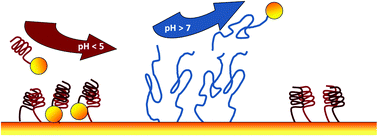Coiled coil peptide-functionalized surfaces for reversible molecular binding
Abstract
We studied the conformational and

* Corresponding authors
a
National Physical Laboratory, Hampton road, Teddington, UK
E-mail:
caterina.minelli@npl.co.uk
Tel: +44 2089436689
b Institute of Biomedical Engineering, Imperial College London, Exhibition road, London, UK
c Faculty of Medicine, Dentistry and Health Sciences, University of Melbourne, Parkville, VIC 3010, Australia
We studied the conformational and

 Please wait while we load your content...
Something went wrong. Try again?
Please wait while we load your content...
Something went wrong. Try again?
C. Minelli, J. X. Liew, M. Muthu and H. Andresen, Soft Matter, 2013, 9, 5119 DOI: 10.1039/C3SM50379H
To request permission to reproduce material from this article, please go to the Copyright Clearance Center request page.
If you are an author contributing to an RSC publication, you do not need to request permission provided correct acknowledgement is given.
If you are the author of this article, you do not need to request permission to reproduce figures and diagrams provided correct acknowledgement is given. If you want to reproduce the whole article in a third-party publication (excluding your thesis/dissertation for which permission is not required) please go to the Copyright Clearance Center request page.
Read more about how to correctly acknowledge RSC content.
 Fetching data from CrossRef.
Fetching data from CrossRef.
This may take some time to load.
Loading related content
